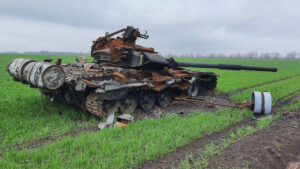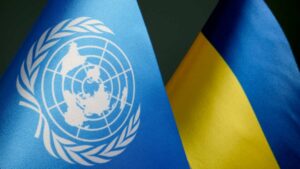
During the war, direct and indirect losses of the agricultural sector reached $40.2 billion, but these are not the final figures, as Ukrainian territories are still under temporary occupation, so it is difficult to calculate the full extent of losses, said Oleksandr Haidu, chairman of the Verkhovna Rada Committee on Agrarian and Land Policy.
“Confirmed direct losses of the agricultural sector exceeded $8.7 billion. We are talking about the destruction of infrastructure, business facilities, logistics chains, destruction and theft of grain and agricultural machinery by the enemy. There are also indirect losses of at least $30.5 billion. Unfortunately, this is not the final figure. When we accurately calculate the damage caused by the enemy’s explosion of the Kakhovka hydroelectric power station, the amount will be much higher,” the MP said on Wednesday at the conference “18 Months of War. Damage to the agricultural sector and prospects for the industry’s recovery”.
According to him, it is difficult to assess the consequences of contamination of agricultural land with explosives, destruction of the upper layers of soil due to “arrivals” and explosions during demining.
“We see that a large area is mined. Potentially, 174 thousand square kilometers of Ukrainian land are contaminated with explosives. And this is without taking into account the temporarily occupied regions,” the MP noted and informed about the preparation of the draft law “On the Quality of Soils”.
Gaidu also emphasized that the state cannot cover the needs of the affected farmers on its own and promised to engage international partners to support the agricultural sector.
“I emphasized the expediency of differentiating programs for farmers. After all, the needs of farmers are very different. For example, those farms that operate in the de-occupied territories cannot attract investment because financial institutions are mostly unwilling to cooperate with them. Although they are the first to return to their places after the liberation of the region to resume their activities and fill local budgets,” he wrote on Facebook.
The chairman of the relevant parliamentary committee believes that one of the mechanisms for compensation for the damage could be “grain reparations,” a mechanism that would help farmers receive compensation for destroyed businesses.

Civilian casualties from February 24, 2022, after Russia launched a full-scale war against Ukraine, to September 10, 2023, totaled 27,149 (26,717 as of August 27), including 9,614 deaths (9,511), the Office of the UN High Commissioner for Human Rights (UN OHCHR) reported.
“The UN OHCHR considers that the actual number of civilian deaths or injuries is significantly higher, as many reports from locations where such incidents have occurred continue to require further confirmation, while information from some locations where fighting continues has been delayed,” the document said regarding the UN data.
This applies, for example, to such localities as Mariupol (Donetsk region), Lisichansk, Popasnaya and Severodonetsk (Luhansk region), where numerous civilian deaths or injuries have been reported.
According to confirmed UN figures, 4,461 men, 2,672 women, 289 boys and 236 girls were killed, while the gender of 29 children and 1,927 adults could not yet be ascertained.
Among the 17,535 injured, 516 boys and 378 girls were killed, while 286 children whose gender could not yet be determined.
Compared to August 27, five children have died and 14 others have been injured.
While the UN OHCHR casualty count summary was previously issued daily, and then only on weekdays, it became weekly from July 2022 and biweekly from the end of May 2023. This summary, like the previous one, provides data by month.
According to them, the UN recorded the deaths of 55 civilians in 10 days in September. In August, the number of new deaths reported dropped to 147 from 161 in July, 186 in June, 174 in May, 182 in April, 181 in March and 144 in February.
The deadliest month for civilians, the UN points out, remains March last year, with a minimum of 4,168 deaths. In April 2022, according to an OHCHR publication, the number of civilian deaths due to war fell to 823 in April, 550 in May, 429 in June and 386 in July. There were 375 deaths in the first five days of the war from February 24 to February 28, 340 in August last year, 408 in September, 310 in October, 188 in November, 206 in December and 201 in January this year.
The number of wounded in the 10 days of September was 237, compared with 565 in August, 688 in July, 679 in June, 685 in May, 492 in April, 592 in March, 457 in February, 538 in January this year, 617 in December and 541 in November last year. In October, the number of injuries dropped to 795 from 983 in September, when it was up from August’s 921. Prior to that the monthly number of wounded exceeded a thousand: July, 1,131; June, 1,109; May, 1,139; April, 1,896; March, 3,001. In the first five days of the war last February, 469 people were wounded.
The UN OHCHR specifies that since the beginning of September, explosive weapons have killed 54 people and injured 170 others, while mines and explosive remnants of war have killed one person and injured 16 (6%).
Government-controlled territories accounted for 79% of casualties in the first 10 days of September, according to the UN.
The summary traditionally states that the increase in figures to the previous summary should not be attributed solely to cases after August 27, as during this period the Office verified a number of cases from the previous days.
Source: https://www.ohchr.org/en/news/2023/09/ukraine-civilian-casualty-update-11-september-2023

The National Agency for the Prevention of Corruption (NAPC) has included Turkish Şişecam Group, which is the largest exporter in the Russian Federation in its industry, in the list of international sponsors of war, the press service of the NAPC reports.
The main areas of activity of the company are glass and chemical production. Şişecam Group is the world’s second largest producer of glassware, the fifth largest producer of glass containers and sheet glass, and a world leader in the production of soda ash and chromium-based chemicals.
Şişecam’s 2022 revenue increased to $3.6 billion and net profit to $740 million.
Since the start of Russian aggression in 2014, Sisecam Flat Glass has been producing architectural, construction and automotive glass in Russia at the Alabuga SEZ in the Republic of Tatarstan. In Russia, Şişecam’s consolidated production volumes of flat glass, glassware and glassware exceed 1.5 million tons per year, with total investments of $1.25 billion. The company provides jobs for 3,414 employees at its plants in Russia, thereby creating jobs and supporting the terrorist state’s economy.
In particular, Şişecam Group’s subsidiaries producing sheet glass, glassware and glass containers paid more than $11.2 million in taxes to the Russian Federation in 2022.
The NAPC release notes that there was no attempt to condemn Russia’s war against Ukraine from the company’s management.
Şişecam Group has two assets in Ukraine – Pivdenna Brewery LLC and Merefianska Sklana Kompaniya.

In Ukraine from April 1, 2022 to April 1, 2023, 203.921 thousand FOPs were closed, while at the same time 208.936 thousand new FOPs and more than 32 thousand companies were registered, according to analytical materials “Opendatabot.”
“Despite full-scale hostilities and blackouts, business in Ukraine continues to grow. At the beginning of April 2023, the total number of registered FPOs amounted to 1.9 million, companies – more than 1.2 million,” – reported in the review.
It is reminded that from the beginning of full-scale war and almost till the end of March, the Unified State Register did not work, therefore it was impossible to register a new business or to close an existing one in the legal field. All data refers to the period from April 1, 2022 to April 1, 2023.
As noted, the military year was not a record for the closure of businesses: at the beginning of April 2023, 203.921 thousand FOPs were closed, while in previous years in Ukraine on average 260 thousand FOPs were closed per year.
At the same time, during the analyzed period – from April 1, 2022 to April 1, 2023 – 208.936 thousand new FOPs were registered.
As the analysts of “Opendatabot” note, in contrast to small and medium-sized businesses, the number of new companies significantly exceeded the number of closed ones. More than 32,000 companies were registered during the war, while 5,728 businesses ceased operations and became inactive.

China unveiled a 12-point peace plan Friday to end the Ukraine-Russia war.
The document, posted on the Foreign Ministry’s website, lists the first point as “respect for the sovereignty of all countries.” “The universally recognized norms of international law, including the purposes and principles of the United Nations Charter, must be strictly observed. The sovereignty, independence and territorial integrity of all countries must be effectively protected,” the text reads.
“A rejection of the Cold War mentality. The security of a country should not be secured at the expense of others. The security of the region should not be ensured by the strengthening or expansion of military blocs,” the 2nd paragraph notes.
Among China’s other proposals is a cessation of hostilities. “All sides should support Russia and Ukraine to work in the same direction and resume direct dialogue as soon as possible in order to gradually de-escalate the situation and eventually reach a comprehensive ceasefire,” it says.
China also proposes resolving the humanitarian crisis, protecting civilians and prisoners of war (POWs), securing nuclear power plants, reducing strategic risks (no nuclear weapons and no nuclear wars), promoting grain exports, ending unilateral sanctions, maintaining the stability of production and supply chains, and promoting post-conflict reconstruction.
The Embassy of the People’s Republic of China in Kyiv specified to Interfax-Ukraine that the document was based on the “four necessities” proposed by President Xi Jinping; the “four common positions” to be followed by the international community; and the “Three Observations” on the crisis.
As the embassy explained, the “four necessities” are that the sovereignty and territorial integrity of all states should be respected, the purposes and principles of the UN Charter should be observed, the rational security concerns of all countries should be taken seriously, and all efforts contributing to a peaceful resolution of the crisis should be supported.”
“The four ‘common positions’ to be followed by the international community imply that the international community should support all efforts contributing to a peaceful resolution of the crisis in Ukraine and call on the parties concerned to remain prudent, exercise restraint, and establish direct contacts as soon as possible and create conditions for renewed negotiations; together oppose the use or threat of use of nuclear weapons, advocate the unacceptability of nuclear weapons and the conduct of nuclear war
“Three observations” on the crisis – “There are no winners in conflicts and wars,” “Complex problems have no simple solutions,” “Confrontations between great nations must be avoided
Meanwhile, on Thursday, the UN General Assembly voted in favor of the resolution “Principles of the United Nations Charter underlying the achievement of a comprehensive, just and lasting peace in Ukraine,” a draft of which was submitted by 57 countries, including Ukraine.
According to the resolution, the General Assembly “reiterates its demand that the Russian Federation immediately, fully and unconditionally withdraw all of its armed forces from the territory of Ukraine within its internationally recognized borders, and calls for a cessation of hostilities.
The resolution also calls for “the immediate cessation of attacks on Ukraine’s critical infrastructure and any deliberate targeting of civilian objects, including homes, schools and hospitals.
China abstained from voting for the resolution.

A drop in sales of more than 30% due to Russian aggression was experienced by 47% of Ukrainian companies, including 19% with a drop exceeding 50%, agriculture, retail, mining and metals industries suffered the most, these are the results of a new business resilience survey presented by the American Chamber of Commerce (AmCham).
“The war has taken a huge toll on Ukrainian businesses, but companies have shown extraordinary resilience and some have even found opportunities for growth,” the report said.
According to a study conducted jointly with McKinsey & Company Ukraine on the eve of the first anniversary of the war, in 2022, 3% of companies increased sales, while 10% either maintained them or kept the decline within 10%. Opportunities for growth were noted by representatives of the banking and financial sectors and IT.
Only 4% reduced the number of employees by more than 30%, while 29% of the companies had the figure in the 10-30% range and 2% even increased the number of staff.
It is indicated that 4% of companies have stopped operations and do not know when they can resume them, while 30% stopped, but have already resumed.
According to respondents, in 2023 the pressure of war on business will remain or even increase. Also among the discouraging forecasts is the reduction of aggregate demand, as GDP growth remains uncertain and the purchasing power of consumers may decline due to depletion of savings, rising unemployment and reduced wages.
As stated in the survey results, 90% of companies have developed internal “contingency plans,” but more than 40% of respondents believe they are not effective enough.
As part of these plans, 61% created pre-war special task forces (multifunctional teams or with a specialization in the risk management function), 33% developed such plans with business units, and 6% enlisted professional outside help to prepare plans. Also, 40% of companies admitted the plan did not work as expected, including 29% who did not foresee the extent of failure and 7% who did not have the necessary resources to implement the plan.
According to the published information, the main military challenge for 25% of respondents was decrease in demand for products or services (60% in machine building, 42% in retail), for 23% – physical damage to facilities (67% in FMCG, 50% in transport/machinery), 19% – disruption of supply chains (pharma – 50%, machine building – 40%).
The problem of energy supply was named as the main problem by 10% of respondents (IT – 30%, banks – 25%), but among the top three problems it is in the lead with 66%, ahead of supply chain disruption 60% and reduced demand 52%.
Among the key priorities for effective contingency planning, companies highlighted an agile operating model and a strong corporate culture.
“While an agile operating model is seen as the most useful factor for overcoming the ongoing crisis, among the priorities companies see for their future development, respondents cited diversification, better contingency planning and building resilient teams,” the survey noted.
In the future to overcome the crisis 46% of companies will pay attention to the strategy and diversification of business, which requires rethinking investment plans, 29% more effectively plan their actions, 18% will attract and maintain a sustainable team and workforce.
The American Chamber of Commerce in Ukraine is the most influential international business association serving over 600 member companies in Ukraine since 1992, bringing the united voice of American, international and Ukrainian companies that have invested over $50 billion in Ukraine and remain committed to the country.